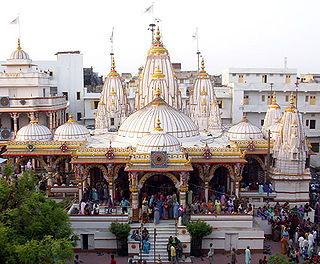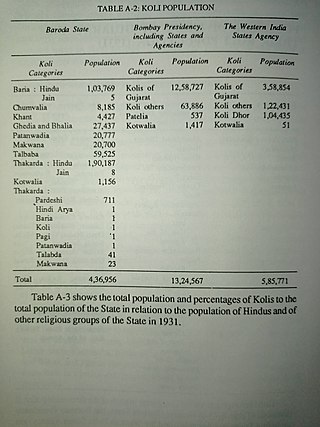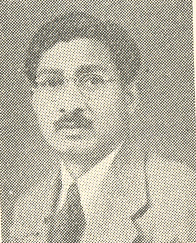Parmar, also known as Panwar or Pawar, is a Rajput clan found in Northern and Central India, especially in Rajasthan, Gujarat, Punjab, Haryana, Uttarakhand, Uttar Pradesh, Bihar, Madhya Pradesh and North Maharashtra. The Panwar ruled in Ujjain and later in Dhar.

Shree Swaminarayan Mandir Kalupur is the first Temple of the Swaminarayan Sampraday, a Hindu sect. It is located in Kalupur area of Ahmedabad, the largest city in Gujarat, India. It was built on the instructions of Swaminarayan, the founder of the sect.
Jethwa is a clan of Rajputs and Koli castes of Gujarat. Jethwa surname is also found among Darji, Mistris of Kutch, and Gurjar Kshatriya Kadias castes of Gujarat.
Kanaji Shankarji Thakor was an Indian politician who served as the mayor of the city of Ahmedabad, in the state of Gujarat, India from 23 April 2008 to 30 October 2010. He is affiliated with Bharatiya Janata Party.

The Pateliya, or Patelia or Patel is a landowning Subcaste of Koli caste found in the Indian states of Gujarat. During the British Raj in India, Patelia Kolis served as tax collectors and administrators. The name Patelia comes from a word meaning village chief. Many Patelia Kolis also went into business and commerce during the Raj period. Patelia Kolis are part of Talapada Kolis of Gujarat.
The Dabhi is a Rajput clan of Gujarat in India. The name is also found among the Indian Kolis.

The Thakor Koli, or Thakore Koli, is a subcaste of the Koli caste of Gujarat. Koli people form the largest caste-cluster in Gujarat, comprising 24 per cent of the total population of the state. Koli Thakors in Gujarat are classified as Other Backward Class (OBC). During his tenure, the former chief minister, Koli community member Madhav Singh Solanki, included all Koli communities of Gujarat in the OBC. Koli Thakors are mostly cultivators or small land-owners.
KHAM stands for Koli Kshatriya, Harijan, Adivasi and Muslim. Here Kshatriya is taken to include the Kolis. In the KHAM combine, Kolis were the largest caste represented at different levels of politics, and Madhavsinh Solanki increased the reservation quota for Other Backward Classes in Gujarat. The theory was propounded by Madhavsinh Solanki in 1980s in Gujarat to create vote bank for Indian National Congress and prepared by Jhinabhai Darji. Using the formula, Congress was able to capture 149 seats in the 182-member Assembly. However the formula alienated Patels permanently from Congress. during the Kham alliance, castes such as Bania, Patidar and Brahmins lost their importance in the state, so they propounded the Anti reservation agitation in 1981 and 1985 in Gujarat to get rid of the power of OBC castes.
The Chavda Koli, is a clan of Hindu Koli community living in the Indian state of Gujarat and union Territory of Daman and Diu.
Katosan is a town and former Princely State in Jotana Taluka of Mehsana district, Gujarat, India.
Gabhaji Mangaji Thakor (koli) was an Indian politician.
Kamlesh Thakor (Koli) (born 19 September 1992) is an Indian cricketer. He made his List A debut on 27 February 2014, for Gujarat in the 2013–14 Vijay Hazare Trophy. He made his first-class debut for Gujarat in the 2017–18 Ranji Trophy on 25 November 2017.
Jugalji Mathurji Thakor is an Indian politician and a member of the Bharatiya Janata Party. He is the member of the Parliament of India representing Gujarat State in the Rajya Sabha, the upper house on 5 July 2019.

Fatehsinhji Ratansinhji Dabhi Thakor (Rajput ) was an Indian politician and Member of Parliament elected during the 2nd General elections of India held in 1957. He represented in modern-day Kheda parliamentary constituency from 1957 to 1962.

Patan Thi Pakistan is a 2013 Gujarati film, starring Vikram Thakor, Pranjal Bhatt and Firoz Irani. Jaimini Trivedi, Paresh Bhatt, Bimal Trivedi, Kaushika Goswami, Rohit Mehta and Trambak Joshi acted in supporting role. Directed by Haresh Patel and produced by Govindbhai Patel, The film tells the story of an inter-religious couple. It was released on 1 November 2013 and was a blockbuster of the year. The film is loosely based on 2001 Hindi film Gadar: Ek Prem Katha.
Harald Tambs-Lyche is a Norwegian ethnologist and social anthropologist.

The Chunvalia, or Chuvalia, Chunwalia is a subcaste of the Koli caste, found in the Indian state of Gujarat. The Chunvalia Kolis were the first Indian caste to adopt the game of cricket in India. Chunvalia Kolis were classified as a Criminal Tribe under Criminal Tribes Act by government of the British Raj because of their purported anti-social behaviour and activities, such as alleged dacoity in Gujarat. During the First World War, Chunwalia Kolis were enlisted as soldiers in British Indian Army by the Bombay government of British India.
Pagi is a title used by the Koli caste of the Indian state of Gujarat during the rule of Mughals, Muslims, British, and princely states in British India. They specialised in the tracking of thieves by means of their footprints. Pagi was a title equal to the detective conferred on the Kolis of Talpada and Chunwalia subcastes.

The Talapada Koli, or Talpada Koli, is a subcaste of the Koli caste of Gujarat state in India. Talapada Kolis are agriculturists by profession. they were members of the Gujarat Kshatriya Sabha, an organisation launched by Natwarsinh Solanki who was a Koli elite. In 1907, they were classified by the British as a Criminal Tribe, ascribing to them a range of anti-social activities such as highway robbery, murder, and theft of animals, cattle and standing crops. They were also alleged to be blackmailers and hired assassins.